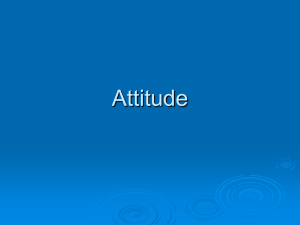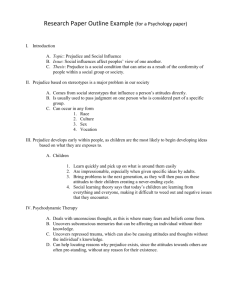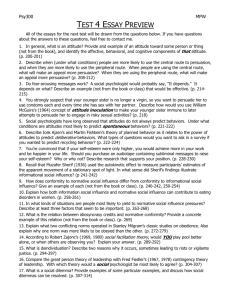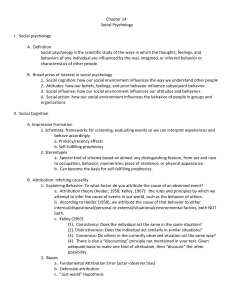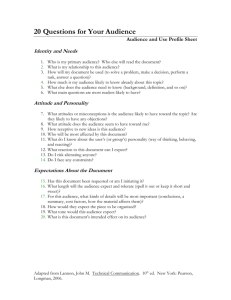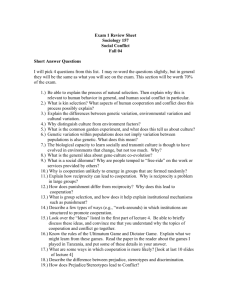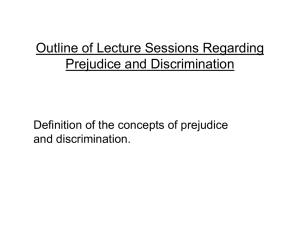Chapter 13
advertisement
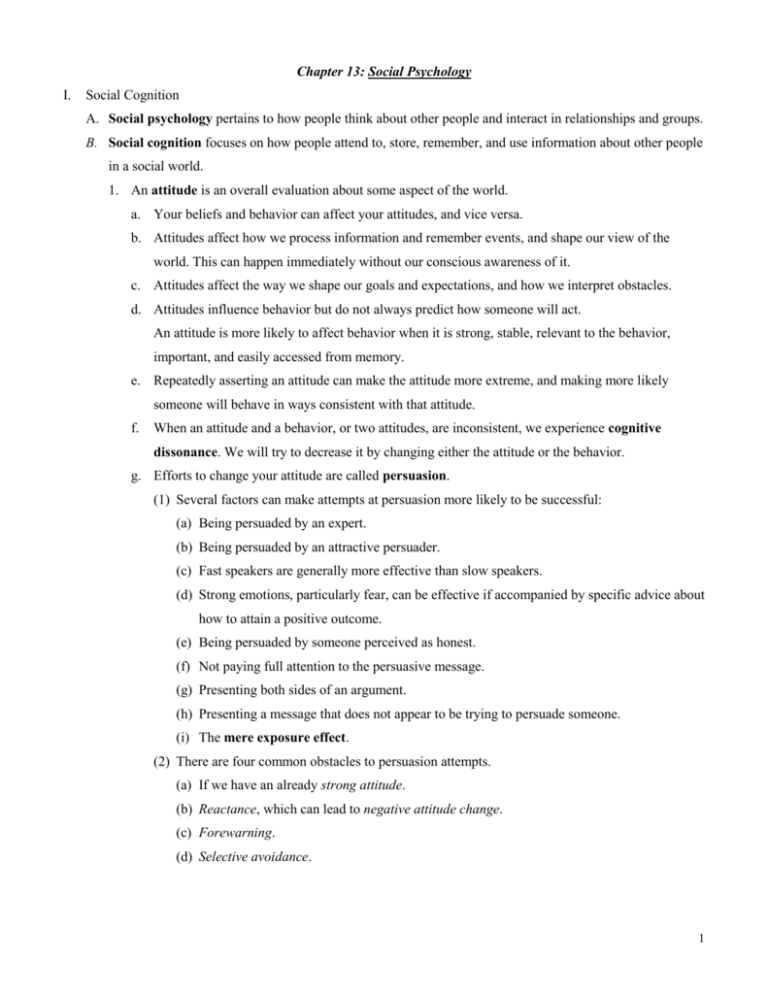
Chapter 13: Social Psychology I. Social Cognition A. Social psychology pertains to how people think about other people and interact in relationships and groups. B. Social cognition focuses on how people attend to, store, remember, and use information about other people in a social world. 1. An attitude is an overall evaluation about some aspect of the world. a. Your beliefs and behavior can affect your attitudes, and vice versa. b. Attitudes affect how we process information and remember events, and shape our view of the world. This can happen immediately without our conscious awareness of it. c. Attitudes affect the way we shape our goals and expectations, and how we interpret obstacles. d. Attitudes influence behavior but do not always predict how someone will act. An attitude is more likely to affect behavior when it is strong, stable, relevant to the behavior, important, and easily accessed from memory. e. Repeatedly asserting an attitude can make the attitude more extreme, and making more likely someone will behave in ways consistent with that attitude. f. When an attitude and a behavior, or two attitudes, are inconsistent, we experience cognitive dissonance. We will try to decrease it by changing either the attitude or the behavior. g. Efforts to change your attitude are called persuasion. (1) Several factors can make attempts at persuasion more likely to be successful: (a) Being persuaded by an expert. (b) Being persuaded by an attractive persuader. (c) Fast speakers are generally more effective than slow speakers. (d) Strong emotions, particularly fear, can be effective if accompanied by specific advice about how to attain a positive outcome. (e) Being persuaded by someone perceived as honest. (f) Not paying full attention to the persuasive message. (g) Presenting both sides of an argument. (h) Presenting a message that does not appear to be trying to persuade someone. (i) The mere exposure effect. (2) There are four common obstacles to persuasion attempts. (a) If we have an already strong attitude. (b) Reactance, which can lead to negative attitude change. (c) Forewarning. (d) Selective avoidance. 1 2. A stereotype is a belief (or set of beliefs) about people in a particular social category. a. Stereotypes can be useful shortcuts, but can affect our expectations of others, which can, in turn, lead them to behave in different ways. b. We are more likely to attend to information consistent with our stereotypes and ignore information inconsistent with those stereotypes. We will notice aspects of people’s behavior that matches our stereotypes about their ethnic group or sex, and ignore other aspects that do not match, thus, ignoring their individual qualities. c. Stereotypes can lead to prejudice. (1) Prejudice can be conscious and intentional, conscious and unintentional, or unconscious and unintentional (2) Social categorization theory claims that people automatically divide the world into “us and them” categories. The ingroup is thought of favorably while the outgroup is usually disliked. (3) The illusory correlation results in white people overestimating crime rates among African American men, etc. (4) The illusion of outgroup homogeneity sees outgroup members as more homogenous than ingroup members (ingroup differentiation). (5) Most Americans believe that discrimination is wrong, are uncomfortable when forced to confront their own discriminatory behavior, and may subsequently reduce its frequency. d. There are many reasons why prejudice exists. (1) Realistic conflict theory argues it is dues to competition for scarce resources. This is supported by research such as the Robber’s Cave study. (2) Social categorization can lead us to behave in ways that elicits behavior from outgroup members consistent with our negative stereotypes (a self-fulfilling prophecy). (3) Once prejudicial attitude in place, social learning theory explains spread and maintained. e. Changing prejudice is difficult, but can be done. (1) The contact hypothesis: increased contact can decrease prejudice under certain conditions: (a) Groups are cooperating toward a shared goal. (b) Groups are similar in social status, etc. (c) Contact is informal and provides opportunity for creating meaningful relationships. (d) The interactions disconfirm prejudicial views. (e) Those in each group view members of the other as typical of their group. (f) The setting assumes equality among participants. (2) Recategorization can decrease prejudice. 3. An attribution is an explanation for the cause of an event or behavior. (1) Internal (dispositional) attributions. Blaming yourself for negative events can suppress the immune system. 2 (2) External (situational) attributions a. An attributional bias is a cognitive shortcut for determining attribution that generally occurs outside our awareness. There are three common attributional biases: 1. The fundamental attribution error 2. The self-serving bias 3. The belief in a just world II. Social Behavior A. Relationships 1. Factors that affect attraction to others a. First impressions b. Repeated contact c. Similarity d. Physical attraction (1) Most research has focused on facial features. (2) People are attracted to faces that are symmetrical, feminized, and “average” looking. 2. Love a. Loving is qualitatively different from liking. b. There are different kinds of “love” (1) Passionate love (2) Compassionate love c. Sternberg’s Triangular model of love (1) Love has three dimensions: (a) Passion, intimacy, commitment (2) Most types of love have only two of the three components. (3) Consumate love has all three components. d. Different styles of attachment result in different kinds of love relationships. (1) A secure style seeks closeness and interdependence. (2) An avoidant style tries to avoid closeness. (3) An anxious-ambivalent style simultaneously wants but fears a relationship. e. Intimacy progresses in ways affected by three factors: (1) feeling understood by your partner. (2) feeling “validated.” (3) feeling that the other person cares for you. f. Mood affects how we feel about our relationships &how we attribute problems in the relationship. 3. Mating preferences a. Evolutionary theory argues we are predisposed to fall in love and tend for children. 3 b. Evolutionary theory argues that men/women look for certain physical attributes in potential mates. (1) Men look for attributes that signal fertility and health. (a) A well proportioned body and symmetrical features. (b) Men focus more on physical attractiveness than women. (2) Women look for men who can protect and nourish them and their children. (a) They look at a male’s earning potential in today’s society. (b) Women focus more on wealth and power than men. (3) As women have become more economically independent, their preferences are becoming more similar to men’s preferences. c. What is deemed attractive is affected by culture and changes over time. C. Social organization 1. A group is a social entity characterized by regular interaction among members, emotional connection, a common frame of reference, and interdependence. a. In a group, loyalties and actions are driven more by group goals than by individual goals. b. Use of internet decreases the size of people’s social circle and increases loneliness and depression. c. Deindividuation can occur in large groups/crowds, can lead to impulsive/violent acts (mob). 2. Norms are rules that govern members of a group. a. There are two kinds: (1) Prescriptive norms dictate acceptable behaviors. (2) Proscriptive norms dictate unacceptable behaviors. b. How we perceive norms can affect how we behave. Antidrug programs that teach why someone should say no to drugs are more effective than programs that teach how to say no. 3. Roles help delineate responsibility within a group and to the group. A status hierarchy reflects distribution of power within a group. D. Yielding to others 1. Conformity is a change in beliefs or actions in order to follow a group norm. a. Even when we are initially certain of something, disagreement by other group members can lead us to doubt ourselves, making us vulnerable to group pressure. b. Solomon Asche’s studies examined factors affecting conformity. (1) Overall, one-third of participants’ responses went along with the incorrect group majority. (2) This number was reduced by several factors: (a) Privacy: writing answers instead of publicly stating them. (b) Social support. c. Group cohesion increases conformity by members. d. Someone from a less powerful group is more likely to conform to norms when accepted into a more powerful group. 4 e. Not everyone is equally affected by group pressure to conform. Culture, desire for independence, and relationship to the group all affect conformity. 2. Compliance is a change in behavior prompted by a direct request rather than social norms. a. Six factors are involved in effective efforts at compliance: (1) Friendship/liking (2) Commitment/consistency (3) Scarcity (4) Reciprocity (5) Social validation (6) Authority b. Several specific techniques make use of some or all of these factors: (1) The foot-in-the-door technique (2) The lowball technique (3) The door-in-the-face technique 3. Obedience is compliance with an order. Milgram’s studies examined factors affecting obedience. 65% of subjects gave the maximum shock. Why? a. The experimental design simulated the foot-in-the-door technique. When allowed to set their own voltage, no subjects went beyond 45 volts. b. People more frequently obey when an order comes from an authority figure. This allows people to deny responsibility for their actions. c. The proximity of the learner and experimenter impacted the results. E. Performance in groups 1. Group decision making a. The majority-win rule works well when a decision involves judgments or opinions. b. The truth-win rule works when there is an objectively correct answer. Groups tend to make better decisions when one solution can be shown to be correct. c. Transactive memory can affect group decision making. d. As a group becomes more heterogenous, it communicates less effectively. (1) Subgroups form leading to some nonsubgroup members feeling alienated. (2) Increased heterogeny can lead to more within-group conflict. (3) Increased heterogeny can lead to improved group performance. e. Group decision making does not always lead to the best solution. (1) One powerful group member can shift opinions to a poor decision. (2) Group polarization can lead to more extreme positions. (3) Groupthink can lead to poor decision making. 5 2. Social loafing is the tendency to work less hard when responsibility for an outcome is spread over the group’s members. This can be reduced by: a. Increasing a sense of individual responsibility in each person’s work. b. Making the task attractive c. Evaluating each individual’s performance 3. Social compensation is when some people work harder in a group than they do when alone. 4. Social facilitation is the increase in performance that can occur simply by being part of a group or in the presence of other people. Works best on simple, well-learned tasks F. Helping behavior 1. Prosocial behavior is acting to benefit others. 2. People are most likely to help if: a. They have a high need for approval. b. They feel personal and social responsibility. c. They have a sense of empathy. d. They believe in a just world. e. They have an internal locus of control. 3. People are more likely to be helped by others if they are: a. Perceived as similar to the potential helper. b. Friends with or liked by the potential helper. c. Perceived as not being responsible for their predicament. d. Able to give socially acceptable justification for their plight. e. Members of the helper’s group. 4. Bystander intervention is affected by factors such as the bystander effect. This can be affected by evaluation apprehension, misperception of the situation, and one’s sense of responsibility in the situation. 6

